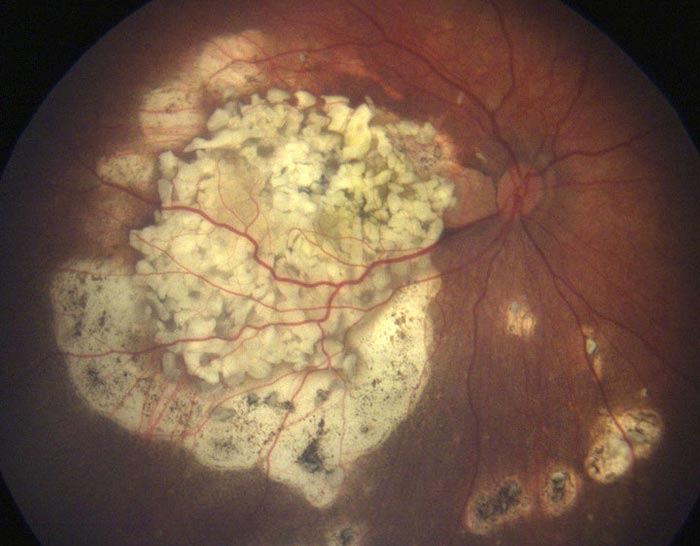New molecular driver of retinoblastoma

Inactive remnant of retinoblastoma tumor following successful intra-arterial chemotherapy
Credit: UT Southwestern Medical Center
Despite decades of medical advances, children who develop the pediatric eye cancer retinoblastoma often lose their vision or an eye due to a lack of specific, targeted therapies and a poor molecular understanding of the cancer. Now researchers at UT Southwestern and the University of Miami have discovered that a molecule – estrogen-related receptor gamma, or ESRRG – becomes hyperactive and promotes tumor cell survival in retinoblastoma. Blocking ESRRG, the team reported in Science Advances, kills retinoblastoma cells.
“Our discovery could lead to innovative new treatments for this cancer that take advantage of this dependence of retinoblastoma on ESRRG,” said study leader J. William Harbour, M.D., Chair and Professor of Ophthalmology at UT Southwestern. Before joining UTSW last year, Dr. Harbour served as Vice Chair for Translational Research at the Bascom Palmer Eye Institute at the University of Miami.
Retinoblastoma is a rare cancer affecting the retina – the tissue in the back of the eye that receives light and converts it into signals to the brain. It is most often diagnosed in children under 2 and has been associated with mutations in the RB1 gene. However, there are currently no specific, targeted therapies; doctors rely on broad-acting chemotherapy drugs that carry numerous side effects and toxicities.
In the new study, Dr. Harbour and his colleagues analyzed genes and proteins in tumor cells from 103 retinoblastoma patients, representing the largest sequencing analysis of retinoblastoma reported to date. While 94% of the tumors contained RB1 mutations, many also contained other altered genes. When the scientists analyzed these other mutations, they discovered that many were involved in the same signaling pathway inside cells: a molecular network that regulates ESRRG. ESRRG is known to play a role in the early development of the retina and other components of the nervous system but had never been linked to retinoblastoma before.
The team went on to show that RB1 normally puts the brakes on ESRRG in normal retinal cells. However, in retinal cells that have transformed into retinoblastoma, ESRRG becomes activated and helps keep cells alive and proliferating, even as oxygen levels drop – normally a signal that kills healthy cells. Blocking ESRRG causes cells to die under these low-oxygen conditions that are common in rapidly growing tumors and inside the eye.
“We found that when cells lose RB1, ESRRG is unleashed to allow continued tumor growth despite low-oxygen conditions,” said Dr. Harbour, a member of the Harold C. Simmons Comprehensive Cancer Center.
The researchers noted that more studies are needed to prove that drugs targeting ESRRG could be used in humans to treat retinoblastoma. But their results are encouraging.
“Retinoblastoma is the most common eye cancer in children, and it is incredibly exciting to finally have a potential drug target,” said Dr. Harbour.
This work was supported by the Alex’s Lemonade Stand/Tap Cancer Out Innovation Grant, University of Miami Sheila and David Fuente Graduate Program in Cancer Biology, University of Miami Center for Computational Science Fellowship, University of Miami Lois Pope LIFE Fellowship Award, Alcon Research Award, NIH/NCI (R01CA248890 and P30CA240139), NIH/NEI (P30EY014801), Research to Prevent Blindness Unrestricted Grant, and a philanthropic gift from M. J. Daily.
Dr. Harbour holds The David Bruton, Jr. Chair in Ophthalmology.
About UT Southwestern Medical Center
UT Southwestern, one of the nation’s premier academic medical centers, integrates pioneering biomedical research with exceptional clinical care and education. The institution’s faculty has received six Nobel Prizes, and includes 26 members of the National Academy of Sciences, 17 members of the National Academy of Medicine, and 14 Howard Hughes Medical Institute Investigators. The full-time faculty of more than 2,900 is responsible for groundbreaking medical advances and is committed to translating science-driven research quickly to new clinical treatments. UT Southwestern physicians provide care in more than 80 specialties to more than 100,000 hospitalized patients, more than 360,000 emergency room cases, and oversee nearly 4 million outpatient visits a year.
Media Contact
News Team
UT Southwestern Medical Center
news@utsouthwestern.edu
Office: 214-648-3404
All latest news from the category: Health and Medicine
This subject area encompasses research and studies in the field of human medicine.
Among the wide-ranging list of topics covered here are anesthesiology, anatomy, surgery, human genetics, hygiene and environmental medicine, internal medicine, neurology, pharmacology, physiology, urology and dental medicine.
Newest articles

Innovative 3D printed scaffolds offer new hope for bone healing
Researchers at the Institute for Bioengineering of Catalonia have developed novel 3D printed PLA-CaP scaffolds that promote blood vessel formation, ensuring better healing and regeneration of bone tissue. Bone is…

The surprising role of gut infection in Alzheimer’s disease
ASU- and Banner Alzheimer’s Institute-led study implicates link between a common virus and the disease, which travels from the gut to the brain and may be a target for antiviral…

Molecular gardening: New enzymes discovered for protein modification pruning
How deubiquitinases USP53 and USP54 cleave long polyubiquitin chains and how the former is linked to liver disease in children. Deubiquitinases (DUBs) are enzymes used by cells to trim protein…



